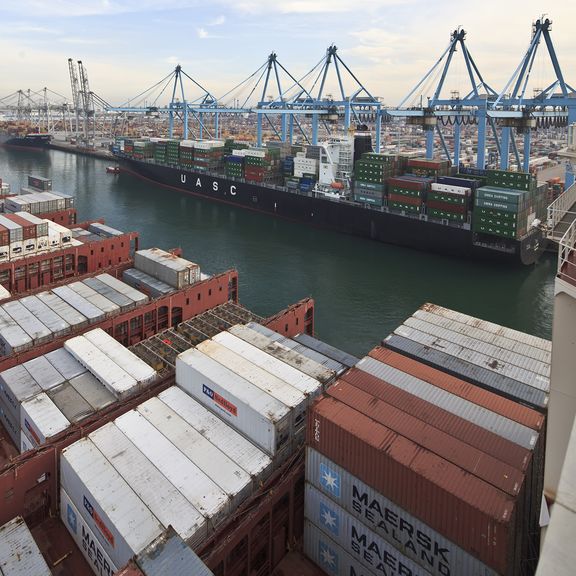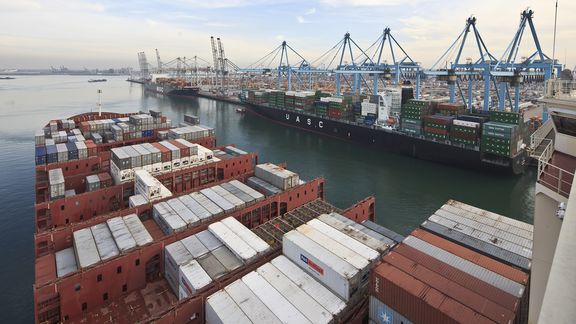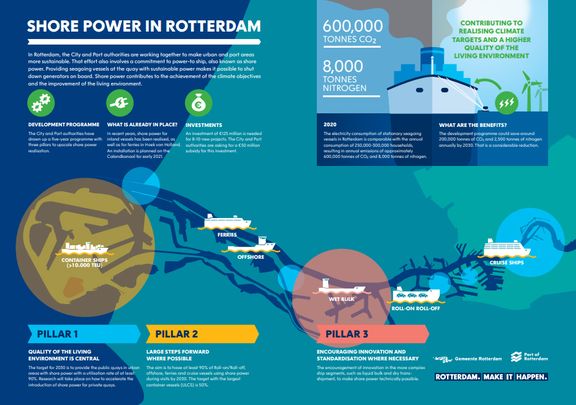
Research on shore-based power at terminals
In Rotterdam, the municipality and the Port Authority are working together to make the city and the port area more sustainable. Onshore power enables us to supply moored seagoing vessels with sustainable power.
Ships are ‘plugged in’ when they are docked and they can switch of their diesel generators. That is good for the air quality and the reduction of CO2emissions. This way, onshore power contributes to achieving the climate objectives and improving the living environment.


Upscalingfrom onshore power
Over the next five years, we will focus on accelerating and scaling up onshore power with a series of projects. With these initiatives, the port of Rotterdam wants to take the lead in making ships in the port more sustainable. With an ambitious target to match: at least 90% of the offshore, ferries, cruise and roll-on-roll-off ships and container ships in Rotterdam must use onshore power by 2030. This will result in an emission reduction of approximately 200,000 tons of CO2 and 2,500 tons of nitrogen. This way, Rotterdam is taking steps towards an increasingly cleaner and future-proof port.
4 Study locations
To further introduce onshore power in the port of Rotterdam, we are conducting four studies in preparation for Onshore Power Supply systems (OPS). This takes place at four large terminals in the port of Rotterdam; the ECT (Amazonehaven), APMT2 (Amaliahaven), VOPAK (Botlek) and the Cruise terminal (Wilhelminakade). The studies consist of different parts; detailed technical studies, environmental and social cost-benefit studies and tendering and permitting procedures.
If the studies turn out well and the parties involved can take a follow-up decision, the work phase will follow, which consists of the realisation of onshore power at the designated locations in the port of Rotterdam.
The onshore power systems will provide 35 MW of power for container ships, liquid bulk and cruise ships by 2025. This creates an alternative energy source for moored ships. The aim is to reduce CO2 emissions and air pollution, and accelerate the market introduction of onshore energy solutions on the mainland.
When will the studies start, can we expect results?
The studies have started and will run until 2023, and the final results are expected to be presented in 2023.
What do the studies consist of?
By winning a European CEF grant, we have started detailed technical, environmental and social cost-benefit studies and tendering and licensing procedures for four terminals.
During the studies, we will examine in particular how onshore power plants can be integrated into regular operation. Important aspects in this regard include the dimensioning of the plant itself, the required space requirement on the quay and further integration into the existing electricity network.
We do this in close collaboration with the container terminal companies ECT and APMT, with tank storage company Vopak and with Cruise Port Rotterdam. Stedin is also closely involved in this. The plan is to complete these studies in 2023 (some well before that).
Which seagoing vessels are prepared to switch to onshore power?
Converting existing ships is relatively expensive, but more and more newly built ships come with an onshore power intake facility. At the moment, only a small proportion of seagoing vessels are ‘onshore power-ready’. It also differs from segment to segment. Shipping companies are looking for clarity with regard to when they can start using onshore power and plans for ship conversions years ahead.
Is there an onshore power standard for seagoing vessels?
Yes, the IEC 80005 is the standard for onshore power in the medium voltage segment (between 6.6 and 11 kV ) and describes how a safe connection can be realised between shore and ship. For the low voltage segment (below 6.6 kV), the standard is advisory only.
Moreover, as a port authority, we are also looking at how we can implement the onshore power facilities to which the standard for the medium voltage segment applies in a pragmatic and smart way, so onshore power remains not only safe but also affordable.
Is a standard for the lower segment in the making?
Large container ships, cruise ships and RoRo ships, are subject to an international standard for medium-voltage onshore power connections (see question 1). For smaller ships with a low voltage connection, the relevant IEC working group is working on a further specification of the standard.
How are ship owners encouraged to prepare their ships for onshore power?
In July 2021, the EU presented its ‘FIT for 55’ plans, with far-reaching proposals for making shipping more sustainable. Onshore power is an important part of making it more sustainable because this way, auxiliary engines of the moored ship can be switched off and the ship can remain on the quay without emissions. This avoids CO2 emissions and improves the environmental quality through lower emissions of nitrogen, particulate matter and noise.
Onshore power for container and passenger ships is expected to become mandatory in 2030. The obligation for the provision of shore power will lie with the Member State. The obligation on the demand side lies with the shipping companies. The EU and the Netherlands also want to stimulate investment in onshore power facilities through temporary project subsidies for the onshore power plants.
In anticipation of the 2030 obligation, the ports of Rotterdam, Hamburg, Antwerp, Bremen and Le Havre have presented their common ambition to offer onshore power infrastructure for the largest container ships by 2028 in an MoU (June 2021). It underlines our ambition to lead the way as the greenest port.
Which ports does the Port of Rotterdam collaborate with on onshore power?
We collaborate with many seaports, so ships in all these ports will soon have access to the plug. For instance, the Port of Antwerp, Hamburg, LeHavre, Bremen, Barcelona, Amsterdam, Moerdijk, Groningen and Vlissingen. And we learn a lot from ports in Los Angeles/California, because they already have a lot of experience with the implementation of onshore power.
What subsidies are available from the government?
A CEF call is currently open for onshore power (European subsidy). More information can be found at Connecting Europe Facility (CEF) Transport | RVO.nl | Rijksdienst (national support centre) or 2021 CEF Transport call for proposals (europa.eu) (subsidy provider).
Are new ships equipped with a plug as standard?
No, but several shipping companies choose to equip the ships with onshore power in certain ship segments, especially cruises and the most modern large container ships.
Onshore power strategy
The Municipality of Rotterdam and the Port of Rotterdam Authority are pursuing a joint strategy and development programme to accelerate and scale up onshore power for seagoing vessels. The aim is for a large proportion of seagoing vessels to be ‘plugged in’ by 2030 when they are moored at the quay.

More information? Contact:
